吉林大学:《药理学》课程PPT教学课件(七年制)Drugs Affecting the Respiratory System
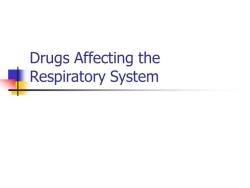
Drugs Affecting the Respiratory System
Drugs Affecting the Respiratory System
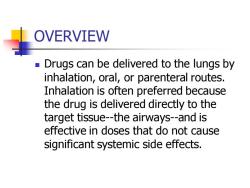
OVERVIEW Drugs can be delivered to the lungs by inhalation,oral,or parenteral routes. Inhalation is often preferred because the drug is delivered directly to the target tissue-the airways-and is effective in doses that do not cause significant systemic side effects
OVERVIEW ◼ Drugs can be delivered to the lungs by inhalation, oral, or parenteral routes. Inhalation is often preferred because the drug is delivered directly to the target tissue-the airways-and is effective in doses that do not cause significant systemic side effects
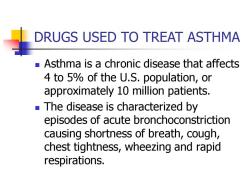
DRUGS USED TO TREAT ASTHMA Asthma is a chronic disease that affects 4 to 5%of the U.S.population,or approximately 10 million patients. The disease is characterized by episodes of acute bronchoconstriction causing shortness of breath,cough, chest tightness,wheezing and rapid respirations
DRUGS USED TO TREAT ASTHMA ◼ Asthma is a chronic disease that affects 4 to 5% of the U.S. population, or approximately 10 million patients. ◼ The disease is characterized by episodes of acute bronchoconstriction causing shortness of breath, cough, chest tightness, wheezing and rapid respirations
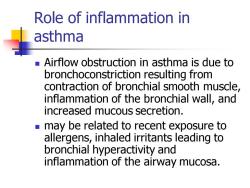
Role of inflammation in asthma Airflow obstruction in asthma is due to bronchoconstriction resulting from contraction of bronchial smooth muscle, inflammation of the bronchial wall,and increased mucous secretion. may be related to recent exposure to allergens,inhaled irritants leading to bronchial hyperactivity and inflammation of the airway mucosa
Role of inflammation in asthma ◼ Airflow obstruction in asthma is due to bronchoconstriction resulting from contraction of bronchial smooth muscle, inflammation of the bronchial wall, and increased mucous secretion. ◼ may be related to recent exposure to allergens, inhaled irritants leading to bronchial hyperactivity and inflammation of the airway mucosa

Adrenergic agonists Inhaled adrenergic agonists with beta-2 activity are the drugs of choice for mild asthma,that is,in patients showing only occasional,intermittent symptoms beta-2 Agonists are potent bronchodilators that relax airway smooth muscle directly
Adrenergic agonists ◼ Inhaled adrenergic agonists with beta-2 activity are the drugs of choice for mild asthma, that is, in patients showing only occasional, intermittent symptoms beta-2 Agonists are potent bronchodilators that relax airway smooth muscle directly
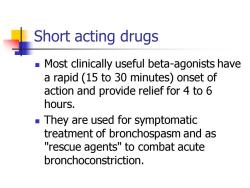
Short acting drugs Most clinically useful beta-agonists have a rapid (15 to 30 minutes)onset of action and provide relief for 4 to 6 hours. They are used for symptomatic treatment of bronchospasm and as "rescue agents"to combat acute bronchoconstriction
Short acting drugs ◼ Most clinically useful beta-agonists have a rapid (15 to 30 minutes) onset of action and provide relief for 4 to 6 hours. ◼ They are used for symptomatic treatment of bronchospasm and as "rescue agents" to combat acute bronchoconstriction
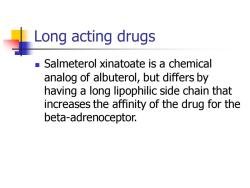
Long acting drugs Salmeterol xinatoate is a chemical analog of albuterol,but differs by having a long lipophilic side chain that increases the affinity of the drug for the beta-adrenoceptor
Long acting drugs ◼ Salmeterol xinatoate is a chemical analog of albuterol, but differs by having a long lipophilic side chain that increases the affinity of the drug for the beta-adrenoceptor
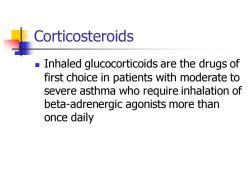
Corticosteroids Inhaled glucocorticoids are the drugs of first choice in patients with moderate to severe asthma who require inhalation of beta-adrenergic agonists more than once daily
Corticosteroids ◼ Inhaled glucocorticoids are the drugs of first choice in patients with moderate to severe asthma who require inhalation of beta-adrenergic agonists more than once daily
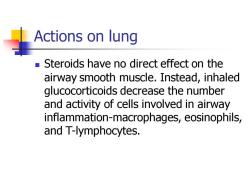
Actions on lung Steroids have no direct effect on the airway smooth muscle.Instead,inhaled glucocorticoids decrease the number and activity of cells involved in airway inflammation-macrophages,eosinophils, and T-lymphocytes
Actions on lung ◼ Steroids have no direct effect on the airway smooth muscle. Instead, inhaled glucocorticoids decrease the number and activity of cells involved in airway inflammation-macrophages, eosinophils, and T-lymphocytes
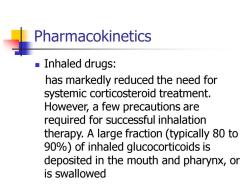
Pharmacokinetics Inhaled drugs: has markedly reduced the need for systemic corticosteroid treatment. However,a few precautions are required for successful inhalation therapy.A large fraction(typically 80 to 90%)of inhaled glucocorticoids is deposited in the mouth and pharynx,or is swallowed
Pharmacokinetics ◼ Inhaled drugs: has markedly reduced the need for systemic corticosteroid treatment. However, a few precautions are required for successful inhalation therapy. A large fraction (typically 80 to 90%) of inhaled glucocorticoids is deposited in the mouth and pharynx, or is swallowed
按次数下载不扣除下载券;
注册用户24小时内重复下载只扣除一次;
顺序:VIP每日次数-->可用次数-->下载券;
- 吉林大学:《药理学》课程PPT教学课件(七年制)Drugs Affecting Blood.ppt
- 吉林大学:《药理学》课程PPT教学课件(七年制)Treatment of Congestive Heart Failure.ppt
- 吉林大学:《药理学》课程PPT教学课件(七年制)Macrolides(Erythromycin).ppt
- 吉林大学:《药理学》课程PPT教学课件(七年制)Drugs Used to Treat Epilepsy.ppt
- 吉林大学:《药理学》课程PPT教学课件(七年制)Antianginal Drugs.ppt
- 吉林大学:《药理学》课程PPT教学课件(七年制)Anticancer Drug.ppt
- 吉林大学:《药理学》课程PPT教学课件(七年制)Anti hypertensive Drugs.ppt
- 吉林大学:《药理学》课程PPT教学课件(七年制)Anxiolytic and hypnotic drugs.ppt
- 吉林大学:《药理学》课程PPT教学课件(七年制)Neuroleptic drugs.ppt
- 吉林大学:《药理学》课程PPT教学课件(七年制)Treatment of Parkinson’s disease.ppt
- 吉林大学:《药理学》课程PPT教学课件(七年制)Antidepressant drugs.ppt
- 吉林大学:《药理学》课程PPT教学课件(七年制)Antimicrobial Agents - General Consideration.ppt
- 吉林大学:《药理学》课程PPT教学课件(七年制)β-Lactam Antibiotics.ppt
- 吉林大学:《药理学》课程PPT教学课件(七年制)Chemotherapeutic Medicine.ppt
- 吉林大学:《药理学》课程PPT教学课件(七年制)Antituberculous drug.ppt
- 吉林大学:《药理学》课程PPT教学课件(七年制)The autonomic nervous system.ppt
- 吉林大学:《药理学》课程PPT教学课件(七年制)Introduction to Pharmacology.ppt
- 吉林大学:《药理学》课程PPT教学课件(七年制)Beta-adrenergic blocking agents.ppt
- 吉林大学:《药理学》课程PPT教学课件(七年制)Adrenergic agonists.ppt
- 吉林大学:《药理学》课程PPT教学课件(五年制)第四十五章 抗结核病药及抗麻风病药.ppt
- 吉林大学:《药理学》课程PPT教学课件(七年制)Opioid Analgesics and Antagonists.ppt
- 吉林大学:《药理学》课程PPT教学课件(七年制)Diuretic Drugs.ppt
- 吉林大学:《药理学》课程PPT教学课件(七年制)Antiarrhythmic drugs.ppt
- 《药理学》课程教学资源(讲义)药理学步进教程(共四十九章).docx
- 石河子大学:《药理学》课程教学资源(教案,共二十八讲).docx
- 《药理学》课程教学资源(讲义)第一篇 药理学总论.pdf
- 《药理学》课程教学资源(讲义)第二篇 传出神经系统药理.pdf
- 《药理学》课程教学资源(讲义)第三篇 中枢神经系统药理.pdf
- 《药理学》课程教学资源(讲义)第四篇 心血管药理.pdf
- 《药理学》课程教学资源(讲义)第五篇 内脏药理.pdf
- 《药理学》课程教学资源(讲义)第六篇 内分泌药理.pdf
- 《药理学》课程教学资源(讲义)第七篇 化疗药物.pdf
- 《药理学》课程教学资源(实验指导)实验二 常用实验动物的捉拿固定和给药方法.pdf
- 《药理学》课程教学资源(实验指导)实验三 不同剂量、不同给药途径、不同机能状态对药物作用的影响.pdf
- 《药理学》课程教学资源(实验指导)实验四传出神经系统药理实验.pdf
- 《药理学》课程教学资源(实验指导)实验五传出神经系统药物对离体肠管的作用.pdf
- 《药理学》课程教学资源(实验指导)实验六局部麻醉药实验.pdf
- 《药理学》课程教学资源(实验指导)实验七 中枢神经系统药理实验.pdf
- 《药理学》课程教学资源(实验指导)实验八 镇痛药和解热镇痛药实验.pdf
- 《药理学》课程教学资源(实验指导)实验十 药物对离体兔心的作用.pdf
